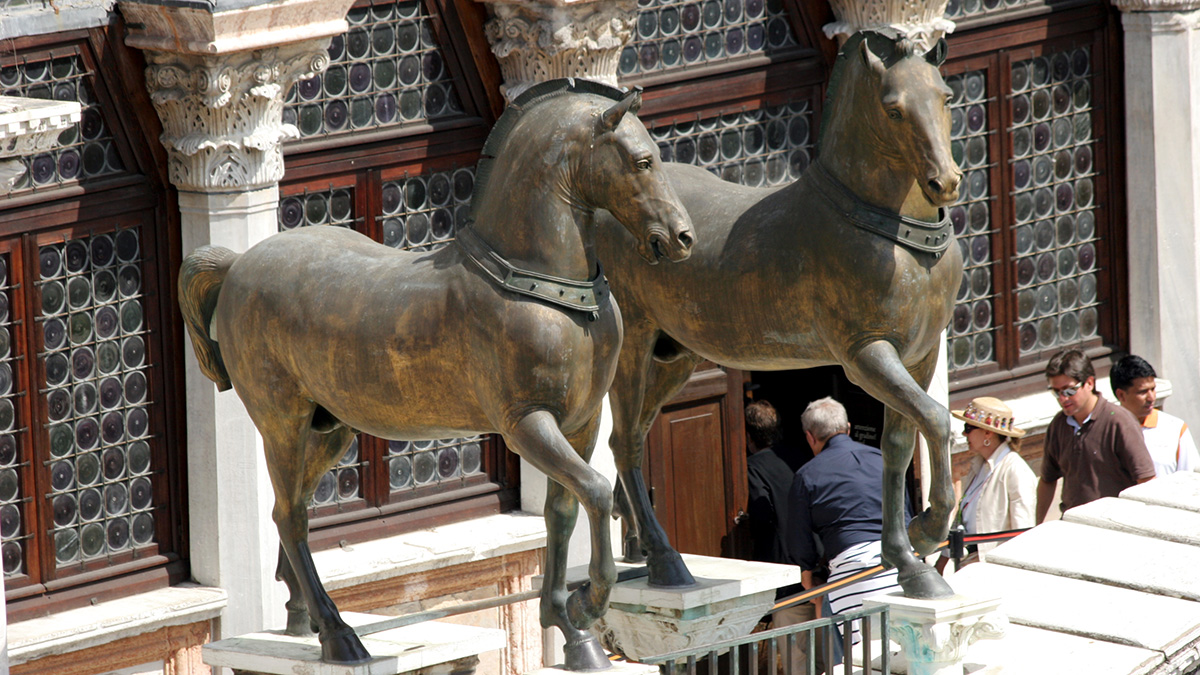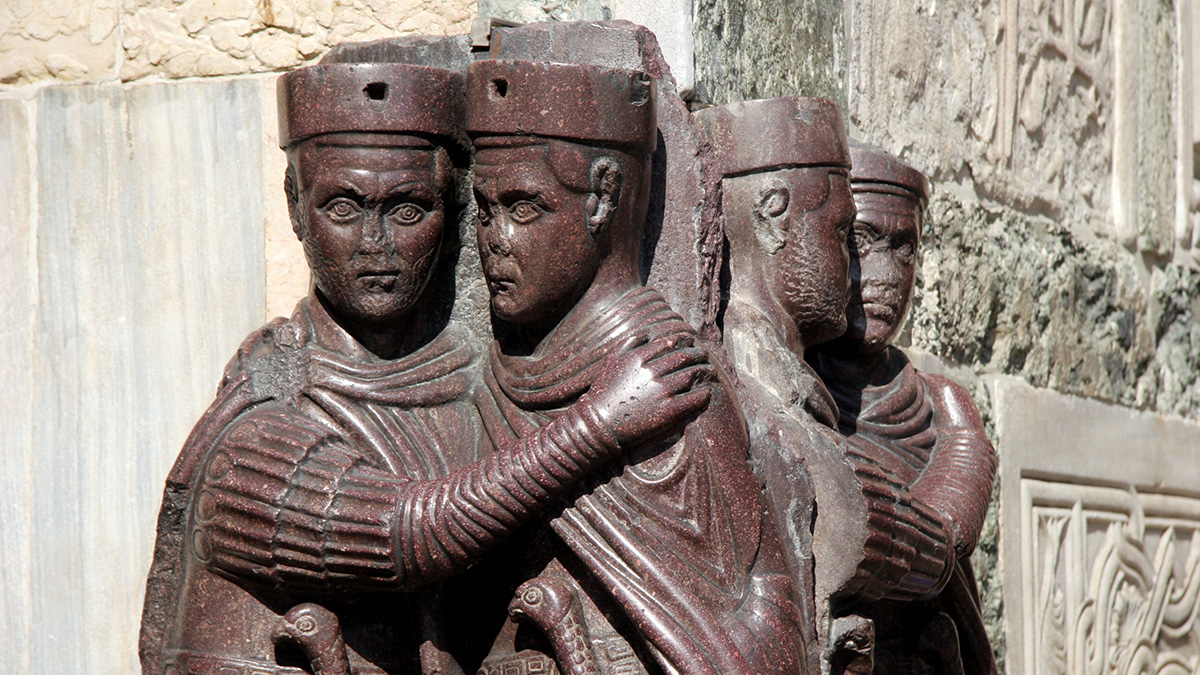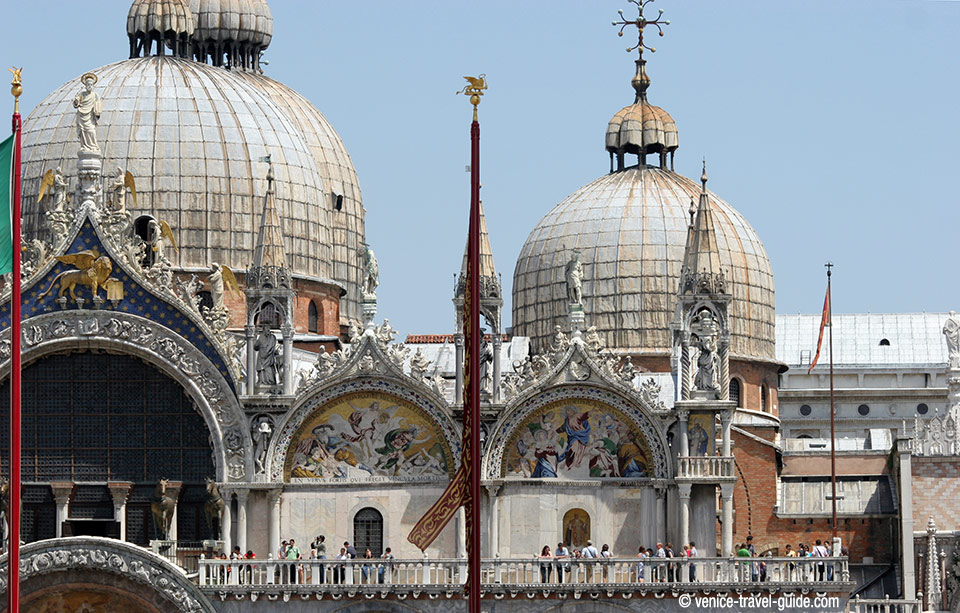The St. Mark's Basilica is the most famous of the city's churches and one of the best known examples of Byzantine architecture. It lies at the eastern end of the Piazza San Marco.
The Basilica di San Marco is adjacent and connected to the Doge's Palace. Originally it was the chapel of the Doge. The church has only been the city's cathedral since 1807, when it became the seat of the Patriarch of Venice, formerly at San Pietro di Castello. For its opulent design, gilded Byzantine mosaics, and its status as a symbol of Venetian wealth and power, from the 11th century on the building has been known by the nickname Chiesa d'Oro (Church of gold).
St. Mark's Basilica Fast-Track Entry and Audio Guide
According to tradition, in 828, two Venetian merchants, Rustico da Torcello and Bon da Malamocco, stole the remains of the evangelist from Alexandria (Egypt) and brought them to Venice, where they received an extraordinary welcome. The doge of the time, Giustiniano Partecipazio, began the construction of a temple to house these relics of such importance. This was replaced by a new church on its present site in 832; from the same century dates the first St Mark's Campanile (bell tower). The new church was burned in a rebellion in 976, rebuilt in 978 and again to form the basis of the present basilica since 1063. The basilica was consecrated in 1094, the same year in which the body of Saint Mark was supposedly rediscovered in a pillar by Vitale Faliero, doge at the time. The building also incorporates a low tower (now housing St Mark’s Treasure), believed by some to have been part of the original Doge's Palace. Within the first half of the 13th century the narthex and the new façade were constructed, most of the mosaics were completed and the domes were covered with higher wooden, lead-covered domes in order to blend in with the Gothic architecture of the redesigned Doge's Palace.
While the basic structure of the building has been much altered, its decoration changed greatly over time. The succeeding centuries, especially the fourteenth, all contributed to its adornment, and seldom did a Venetian vessel return from the Orient without bringing a column, capitals, or friezes, taken from some ancient building, to add to the fabric of the basilica. Gradually, the exterior brickwork became covered with various marbles and carvings, some much older than the building itself.
Facade facing the square of the St. Mark's Basilica
The exterior of the basilica is divided in three registers: lower, upper, and domes. In the lower register of the façade five round-arched portals, enveloped by polychrome marble columns, open into the narthex through bronze-fashioned doors. Above the central door round three bas-relief cycles of Romanesque art. The external cycle frames a 19th century gilded mosaic (Last Judgment) that replaced a damaged one with the same subject (during the centuries many mosaics had to be replaced inside and outside the basilica, but subjects were never changed). Mosaics about St Mark relics’ stories are in the lunettes of the lateral portals; the first on the left is the only one in the façade preserved from the 13th century. In the upper register, from the top of ogee arches, statues of Theological and Cardinal Virtues, four Warrior Saints and St Mark watch over the city. Above the large central window of the façade, under St Mark, the Winged Lion (his symbol) holds the book quoting “Pax Tibi Marce Evangelista Meus” (Peace to you Mark my evangelist). In the lunettes of the lateral ogee arches are four gilded mosaics renewed in the 17th century.

Bronze horses of St. Mark's Basilica
The upper arcade, with a balustrade, is embellished by four gilded bronze horses. This Byzantine work of art is the only ancient quadriga preserved today. The magnificent horses arrived in Venice in 1204 with the immense war booty taken by the Venetians, under Doge Enrico Dandolo, after the conquest of Constantinople in the Fourth Crusade. They date to Classical Antiquity; by some accounts they once adorned the Arch of Trajan. The horses were long displayed at the Hippodrome of Constantinople.
They were taken to Paris by Napoleon in 1797 but returned to Venice in 1815. After a long restoration, since the 1990s they have been kept in St Mark’s Museum (inside the basilica). The horses now on the facade of the cathedral are bronze replicas.

The Tetrarchs in the St. Mark's Basilica
The Tetrarchs are a red porphyry sculpture located in the corner of the treasure chamber of St. Mark's Basilica in Venice. The Tetrarchs were part of the loot obtained by the Venetians in the eastern Mediterranean.
In an attempt to stabilise the Roman Empire after the crisis of the third century, the Emperor Diocletian imposed a new Imperial office structure: a four co-emperor ruling plan called The Tetrarchy. This porphyry statue represents the inter-dependence of the four rulers. The sculpture, dating from the 4th century, most likely depicts the Roman Emperor Diocletian and his co-emperors Maximian, Constantine and Valerius.
It was taken from Constantinople, during the Fourth Crusade in 1204, and set into the south-west corner of the basilica (the above mentioned low tower) at the level of the Piazza San Marco. The missing foot of one of the figures was discovered in Istanbul in the 1960s, where it is still on display.
A Venetian legend says that the figures correspond to four Moors who intended to steal the relics of Saint Mark. Thanks to a miracle performed by the saint, the four thieves were turned into stone statues and remain in place to scare away potential thieves.
Narthex
Originally, the narthex embraced the western arm of the basilica on the three sides; later the southern part was closed to obtain the Baptistery (14th century) and the Zen Chapel (16th century). The narthex prepare the visitors’ eyes to the suffused atmosphere of the gilded interior, just like the Old Testament stories represented in its mosaic ceiling prepare to the Gospel of the basilica’s. The main subjects are Genesis and the life of Noah, Abraham, Joseph, Moses. Beside the main portal remain the Evangelists, 11th century mosaics that decorated the entrance to St Mark’s even before the narthex was built.
Interior
The interior is based on a Greek cross, with each arm divided in three naves and emphasized by a dome of its own. This is based on Justinian's Basilica of the Apostles in Constantinople. The marble floor (12th century, but underwent many restorations) is entirely tessellated in geometric patterns and animal designs. The techniques used were opus sectile and opus tessellatum. The lower register of walls and pillars is completely covered with polychrome marble slabs. The transition between the lower and the upper register is delimited all around the basilica by passageways which largely substituted the former galleries.
The eastern arm has a raised presbytery with a crypt beneath. The presbytery is separated by an altar screen formed by eight red marble columns crowned with a high Crucifix and statues by Pier Paolo and Jacobello Dalle Masegne, masterpiece of Gothic sculpture (late 14th century). Behind the screen, marble banisters with Sansovino's bronze statues of the Evangelists and Paliari's of the Four Doctors mark the access to the high altar, which contains St Mark’s relics. Above the high altar is a canopy (“ciborium”) on columns decorated with remarkable relieves; the altarpiece is the famous Pala d'Oro (Golden Pall), a masterpiece of Byzantine craftsmanship, originally designed for an antependium. The choir stalls are embellished with inlaying by Fra Sebastiano Schiavone, and above them on both sides are three relieves by Sansovino.
Behind the presbytery are the sacristy and a 15th century church consecrated to St Theodore (the first patron saint of Venice) where is displayed a painting (Child’s Adoration) by Giovanni Battista Tiepolo.
On the right of the screen is the platform from which the newly-elected doge appeared. In the left aisle are St Clement’s chapel and the Holy Host altar. Here is the pillar where St Mark’s relics were rediscovered in 1094, as depicted in the interesting mosaics of the right aisle (where the entrance to St Mark’s Treasure is). On the left of the screen is the platform for the Holy Scripture reading; on the right aisle are St Peter’s chapel and the Madonna Nicopeia, a venerated Byzantine icon. On the northern side are St Isidor’s chapel and the Mascoli chapel.
The upper order of the interior is completely covered with bright mosaics containing gold, bronze, and the greatest variety of stones. The decorated surface is on the whole about 8000 m2. In the most ancient works, both Byzantine and Gothic influences can be recognized, as for example in the Saints from the 11th century between the windows of the apse. In the vault above is a mosaic with Christ Pantocrator. From the apse towards the entrance (from east to west) one can contemplate the history of Salvation in the domes: the Prophets, the Ascension and the Pentecost (Whitsun). The domes over the transept are called St John’s (stories of St John the Evangelist) and St Leonard’s (with other saints). In the vaults between the domes are represented episodes of Jesus’ life. As mentioned above, restorations and replacements were often necessary thereafter, and great painters such as Paolo Uccello, Andrea del Castagno, Paolo Veronese, Jacopo Tintoretto and his son Domenico took part drawing the cartoons. Tiziano and the Padovanino prepared the cartoons for the sacristy, built in the late 15th century. Other remarkable mosaics decorate the Baptistery, the Mascoli Chapel, St Isidor Chapel and the Zen Chapel.
St. Mark's Basilica Opening Hours
- Open daily: 09:30 - 17:15. Last admission 16:45. Sundays from 2:00 p.m.
- Bell tower. Open daily: 09:30 - 21:15. Last admission 20:45.
- Closed on December 25th and January 1st.
Map of St. Mark's Basilica


